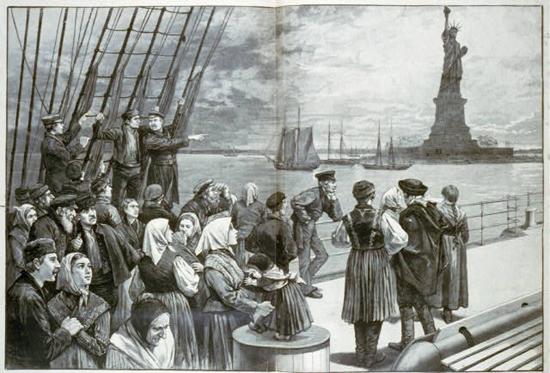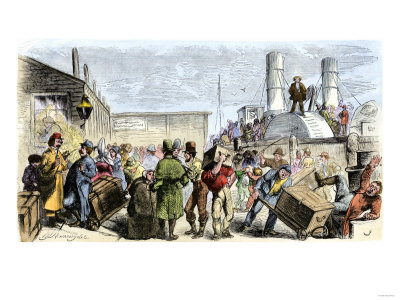Jun 15 2011
Posted by Rebecca Somers under June 16 Assignment
Westward Expansion
New York state was one of the most populated states pre-Constitution, which is why she had such an influence in the development of America. Since the days of Hamilton, New York was seen as a symbol of capitalism and the “American dream” through a vibrant economy. Hamilton was an inspirational lawyer with the mind of a true businessman. Wall Street was established when President George Washington was inaugurated. The path of NYC seemed to be one of entreprenural, investing, and trading. With this came manufacturing and small sweatshops (nothing like the high rises we see today). I think it was part of New Yorkers destiny to “keep up with the Jones’” because already by 1845, the upper 4% of owned 49% of the cities wealth (Chudacoff, pg. 48). This monetary difference caused the beginnings of the division between the upper and lower classes and the establishment of a middle class. “Housed in mansion, transported in private carriages, clothed in the finest fabrics, fed the choicest delicacies, waited on by servants…the wealthiest residents could remove themselves from contact with the new urban masses (pg. 48). This lifestyle and urbanization contrasted greatly with those cities Out West mainly because of geography and also because of the identity of the settlers.
“Many an optimistic urban speculator from the East came West holding a deed only to find his property located in a mosquito invested swamp (Chudacoff, 42). This explains how the successes of the few still inspired risk takers to make it big in a new and foreign city with lots of rising opportunity. Like New York, the wealth individuals had affected their style of living. And in cities Out West money paid for property and land improvements (Chudacoff, 43). This is an example of a privatized system that had no issue providing special treatments for the people that could afford, while in other cities, like New York, local governments paid for water supplies, firefighting equipment, canals and turnpikes. The beginning of Westward expansion was after the War of 1812 and the construction of an intercontinental railroad. New York and the original thirteen colonies already had an economic advantage, so the Western Territories had to catch up quickly in population and wealth. Geographically, the West had all of these great rivers and waterways that would be of value to them with the introduction of steamships.


 Mobile and New York City were two remarkable cities during the 19th century. In the north New York dominated the trading scene as one of the most popular and business driven ports along the East Coast. While in the south New York City’s “younger brother” Mobile, Alabama was one of the largest international seaports on the Gulf Coast.
Mobile and New York City were two remarkable cities during the 19th century. In the north New York dominated the trading scene as one of the most popular and business driven ports along the East Coast. While in the south New York City’s “younger brother” Mobile, Alabama was one of the largest international seaports on the Gulf Coast.










 Difference
Difference
 ave their share of differences and similarities. The most obvious difference is that one is a city from the North while the other is a city from the South. Each has it’s own different lifestyle. With the North being more notable for freedom for slaves and industrial services, the South was none for its intolerance towards slave freedom and their agriculturalist lifestyle. For New Orleans, this wasn’t held completely true. New Orleans “resembled northern counterparts in their commercial functions and social complexity” ( Chudacoff and Smith page 72) Although they were one of the few cities that had commercial functions, the business people relied heavily on the Northern capital and markets. This big one similarity, one difference between New Orleans and New York was that in New York diversity was well known and in a sense accepted. In New Orleans the French speaking people and the English speaking people had to be divided in the city “between a French quarter and an American Quarter, separated by a street with a broad medican called the Neutral Zone” (Chudacoff and Smith page 67) The diverse population in New York was in a sense mixed weren’t living in their own sections as was the case in New Orleans.
ave their share of differences and similarities. The most obvious difference is that one is a city from the North while the other is a city from the South. Each has it’s own different lifestyle. With the North being more notable for freedom for slaves and industrial services, the South was none for its intolerance towards slave freedom and their agriculturalist lifestyle. For New Orleans, this wasn’t held completely true. New Orleans “resembled northern counterparts in their commercial functions and social complexity” ( Chudacoff and Smith page 72) Although they were one of the few cities that had commercial functions, the business people relied heavily on the Northern capital and markets. This big one similarity, one difference between New Orleans and New York was that in New York diversity was well known and in a sense accepted. In New Orleans the French speaking people and the English speaking people had to be divided in the city “between a French quarter and an American Quarter, separated by a street with a broad medican called the Neutral Zone” (Chudacoff and Smith page 67) The diverse population in New York was in a sense mixed weren’t living in their own sections as was the case in New Orleans.







 Urban expansion in America from 1800 to 1865 was impressive. There was an intense competition of urbanization among many cities. Transportation improvement, for example, played a big role in the development of both New York City and Chicago. Like New York City, Chicago benefitted from the establishment of Erie Canal. The 363-mile canal, running west from Hudson River at Albany to Lake Erie at Buffalo, completed the job of linking the Atlantic Ocean to the Great Lakes. The connection among Erie Canal, and Lakes Erie, Huron, and Michigan made it possible for Chicago to extend its trade with other regions despite its location in the interior of the continent. Allowing a new route of water travel, the canal largely reduced the shipping costs. Due to this advantage, Chicago emerged as one of the largest lake ports in the region. New York City also benefitted from Erie Canal since the canal extended its trade from New York State to the entire Great Lakes System. Thanks to this transportation improvement, the economy of New York City grew even more rapidly, and manufacturing was spread out.
Urban expansion in America from 1800 to 1865 was impressive. There was an intense competition of urbanization among many cities. Transportation improvement, for example, played a big role in the development of both New York City and Chicago. Like New York City, Chicago benefitted from the establishment of Erie Canal. The 363-mile canal, running west from Hudson River at Albany to Lake Erie at Buffalo, completed the job of linking the Atlantic Ocean to the Great Lakes. The connection among Erie Canal, and Lakes Erie, Huron, and Michigan made it possible for Chicago to extend its trade with other regions despite its location in the interior of the continent. Allowing a new route of water travel, the canal largely reduced the shipping costs. Due to this advantage, Chicago emerged as one of the largest lake ports in the region. New York City also benefitted from Erie Canal since the canal extended its trade from New York State to the entire Great Lakes System. Thanks to this transportation improvement, the economy of New York City grew even more rapidly, and manufacturing was spread out.